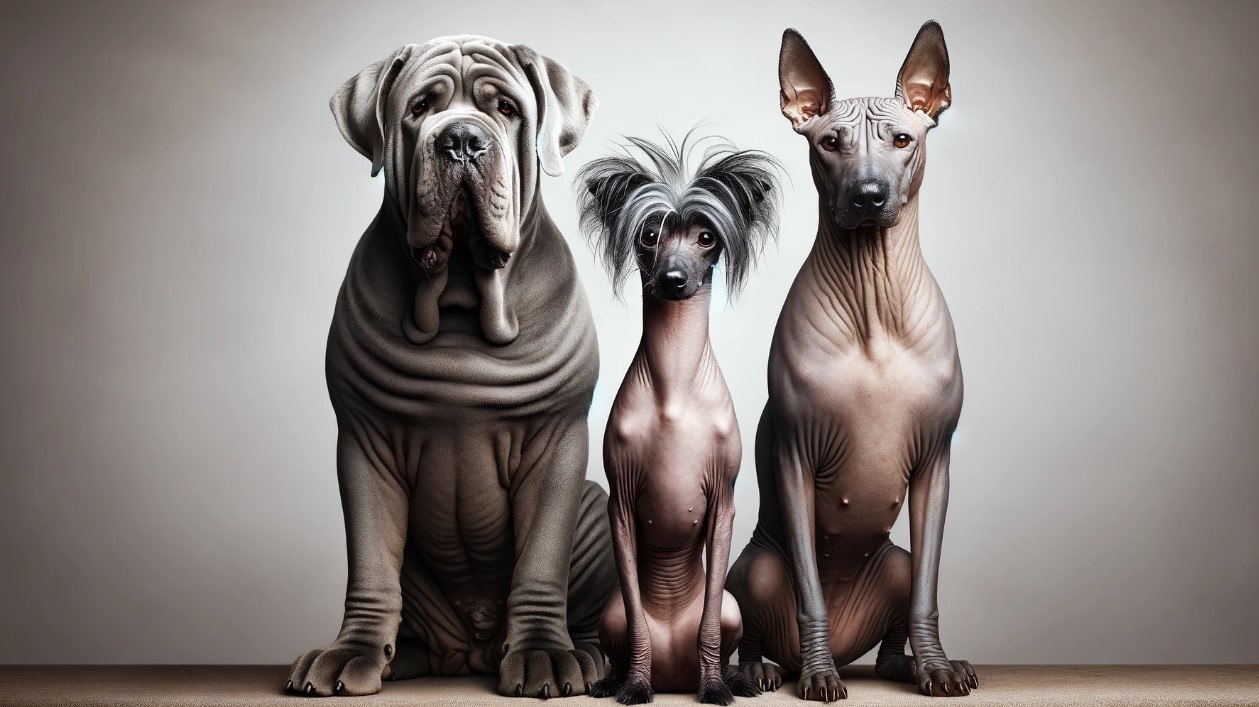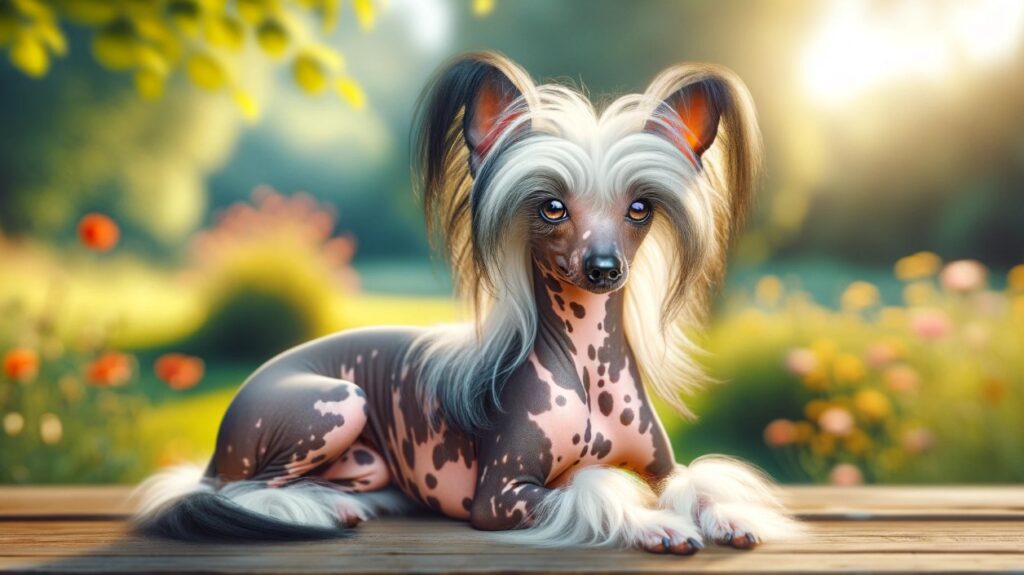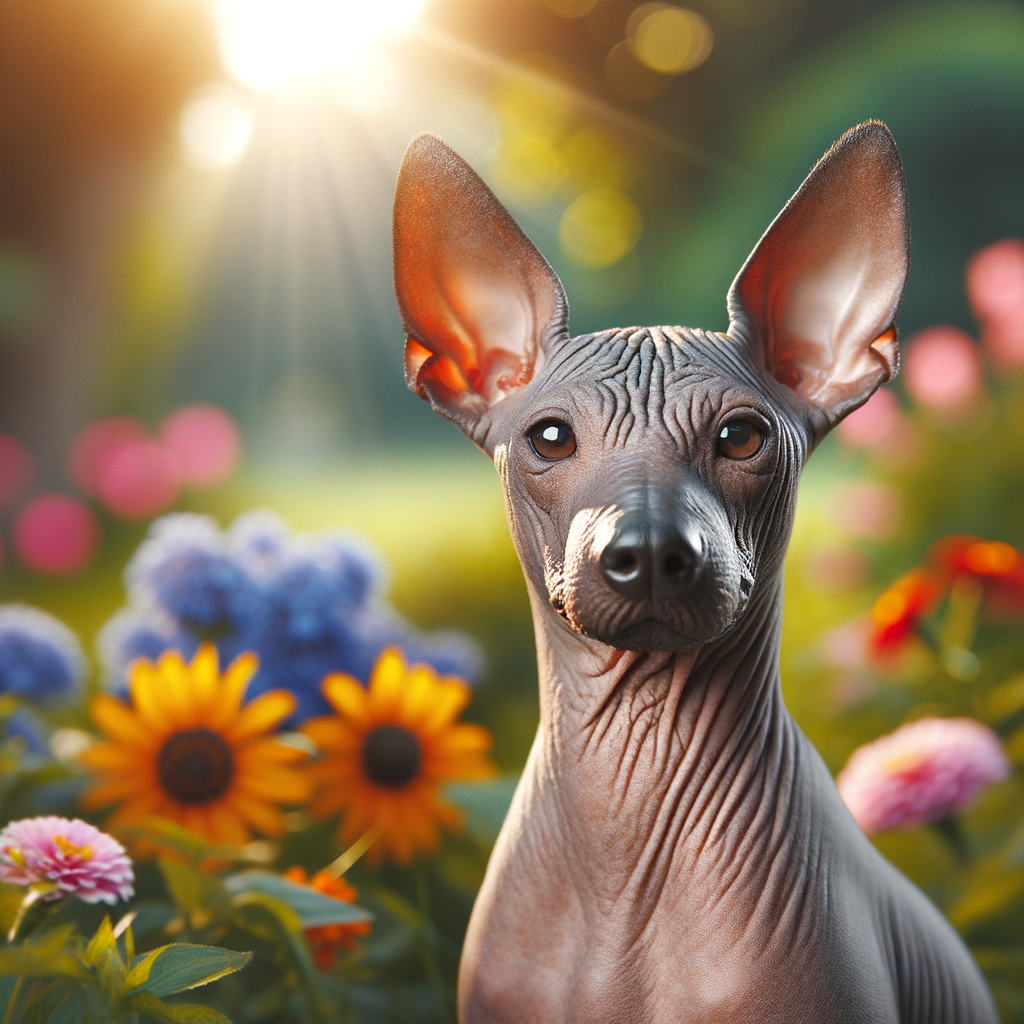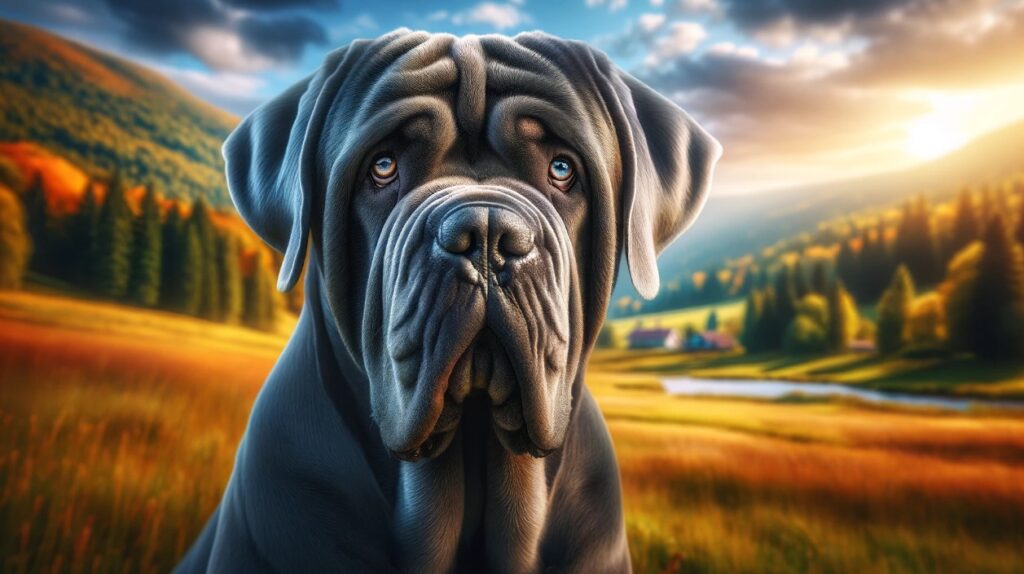As a holistic veterinarian, I have seen my fair share of dogs, from the common breeds we all know and love to the weirdest dog breeds that make you do a double-take. There’s a wide array of canine diversity out there, each breed with its own uniqueness and charm. The world of dogs is not all Labradors and Golden Retrievers; it’s filled with breeds that defy the norm, offering a delightful blend of weird and wonderful.

What makes a dog breed “weird”? Well, it could be anything distinctive about its appearance, behaviour, or history. Perhaps it’s an unusual coat, an unconventional size, or an intriguing historical background. Sometimes, these quirks are a result of the breed’s evolution or cultural influences. However, regardless of what makes them different, these unique dog breeds offer a fascinating glimpse into the canine kingdom’s extraordinary diversity.
Now, when it comes to describing the weirdest dog breeds, we’re going to delve into their history, their prominent features, and what makes them so unique. We’ll also take a look at their common health issues, how to care for them, and the best training techniques to use. If you’re considering adopting one of these breeds, I’ll also share some considerations to keep in mind and what it’s like to be an owner of one of these unique pups.
So, if you’re a dog lover with a penchant for the peculiar, or you’re just interested in learning more about the canine world’s oddballs – you’re in the right place. By the end of this piece, I hope you’ll embrace these unusual dog breeds and their peculiarities, appreciating the joy and challenges they bring to the dog ownership experience.
The Definition of “Weird” in Dog Breeds
Ever wonder what turns an ordinary dog breed into an extraordinary one? Let’s delve into the fascinating world of ‘weird’ dog breeds. As a holistic veterinarian, I’d love to share my insights on what makes certain breeds stand out as peculiar or exotic in the canine kingdom.
Factors that Make a Dog Breed Weird
Weird or unusual can be relative terms when it comes to dog breeds. What’s considered ‘weird’ can vary from one person to another, depending on individual perceptions and cultural norms. However, there are certain factors that generally contribute to a breed being labeled as ‘weird’.
– Physical attributes: This is often the first thing that strikes us. Some dog breeds may have distinctive features such as unusual coat colors, unique patterns, oddly placed eyes, or extraordinarily large or small sizes.
– Behavioral traits: Dogs with peculiar behaviors also fall into the ‘weird’ category. This can range from unique communication styles to unusual eating habits or quirky sleeping patterns.
– Breed history: Some breeds have a weird history or origin that sets them apart. They might have been bred for unique purposes or in uncommon environments.
The Impact of Breed Characteristics on Weirdness
What does the ‘weird’ tag mean for these breeds? More often than not, these unique characteristics have a significant impact on how these breeds are perceived, cared for, and even trained.
– Perception: Sadly, some people might find these breeds unattractive or unsettling due to their distinctive features. On the flip side, other people are drawn to these breeds specifically because they stand out from the crowd.
– Care: Some of these breeds may require special care due to their unique physical attributes. For instance, dog breeds with unusual fur might require extra grooming, while those with specific dietary needs due to their breed history may need a specialized diet.
– Training: Certain ‘weird’ behaviors might necessitate special training approaches. Understanding the breed’s unique traits can help in devising effective training techniques.
In essence, the ‘weirdness’ of a dog breed doesn’t make it any less lovable or fascinating. In fact, it’s these very quirks that make these breeds so special and endearing to their owners. As we go in search of the weirdest dog breeds, remember, these breeds are not just oddities but also unique creatures with their own charm and characteristics that make them truly one of a kind in the vast canine kingdom.

The History and Origin of Weird Dog Breeds
Understanding the weirdest dog breeds often involves going back in time to explore their origins and unique histories. These breeds didn’t just occur naturally; they were developed over centuries, sometimes deliberately, for specific purposes or environments.
Evolution of Weird Dog Breeds
Just as every dog breed has a history, the weirdest dog breeds have a story to tell. The evolution of these breeds is often a compelling journey marked by fascinating twists and turns. For instance, the Chinese Crested, a breed renowned for its lack of hair and skin “tattoos,” was bred deliberately to be a rat-catcher on Chinese trading ships centuries ago. Its lack of fur made it less appealing to fleas, a common shipboard pest.
The Bedlington Terrier, a breed that more closely resembles a sheep than a dog, was developed in the 19th century in England’s mining town of Bedlington as a versatile working dog. Its light, nimble build and courageous nature made it an effective hunter of vermin, while its distinctive woolly coat offered protection from the harsh weather.
By understanding the origins of these breeds, we gain insight into the factors that contribute to their unique – sometimes bizarre – appearance and behavior.
Cultural Influence on Weird Dog Breeds
Culture plays a significant role in the development of different dog breeds. Consider the Neapolitan Mastiff, a dog that was prized in ancient Rome for its intimidating look and was used as a war dog. This breed has been preserved throughout the centuries due to its cultural significance, despite its droopy skin and enormous size making it one of the weirdest breeds around.
The Mexican Hairless, or Xoloitzcuintli, is another breed deeply rooted in cultural history. Revered by the Aztecs, Toltecs, and Maya as a sacred dog, they were considered guardians of the dead and were often buried with their owners to guide them in the afterlife. Their lack of hair was believed to give them special healing abilities, a legacy that continues to this day in Mexican and Central American folklore.
The Inca Orchid, another hairless breed from South America, has been part of Peruvian culture for over a thousand years. They were kept in Incan temples and were considered to have mystical properties. Their cultural significance has preserved this unique breed with its spotted skin and hairless body.
These are just a few examples of how history and culture have shaped the weirdest dog breeds we know and love today. Each breed is a testament to the diversity and creativity of human’s relationship with dogs, from their development for specific roles to their preservation for cultural significance.
The Bedlington Terrier
The Bedlington Terrier could easily be mistaken for a lamb with its woolly, curly coat and pear-shaped body. Originating from the mining town of Bedlington, England, this breed was used for ratting and racing. Despite its unusual appearance, the Bedlington Terrier is known for its agility, speed, and hardiness. They are also known to be intelligent, good-tempered pets that are loyal to their families.
The Chinese Crested
A member of the toy group, the Chinese Crested comes in two varieties: the hairless Chinese Crested and the Powderpuff. The hairless variety is what makes this breed one of the weirdest dog breeds due to their spotty, hairless bodies with tufts of hair on their heads (the crest), tails (the plume), and feet (the socks). Despite their exotic looks, they are affectionate, playful, and great companions.
The Bergamasco Shepherd
The Bergamasco Shepherd, with its distinctive matted coat, is a breed that’s hard to forget once you’ve seen one. This breed was developed in the Italian Alps and was primarily used as a herding dog. Their unique coats, which form ‘flocks’ or loose mats, can reach the ground and provide protection against weather and predators. Beneath the unusual coat, you’ll find a muscular, intelligent dog that is patient and eager to please.
The Puli
The Puli is a medium-sized herding dog known for its tight, woolly curls that look more like dreadlocks. Originating from Hungary, this breed has a long history of herding sheep. The cord-like coat, which is the product of a unique process where the undercoat and outer coat naturally clump together, provides insulation and protection. Pulis are known to be intelligent and energetic, with a good sense of humor.
The Neapolitan Mastiff
The Neapolitan Mastiff is a large breed known for its loose, wrinkled skin and massive size. Originating from Italy, this ancient breed was used as a war dog and guard dog. While their appearance might be intimidating, Neapolitan Mastiffs are known to be calm, peaceful dogs that are devoted to their families.
The Xoloitzcuintli
Often just called the “Xolo,” this breed is one of the oldest and rarest breeds. Xolos come in three sizes and can be hairless or coated. The hairless Xolo is definitely the weirder of the two with their smooth, tough skin and tuft of hair on the head and tail. They were considered sacred by the Aztecs, Toltecs, and Maya. These dogs are known for their loyalty, intelligence, and reputation for healing their owner’s physical and emotional ailments.
Weirdness in dog breeds, just like in humans, should be celebrated. These unique breeds each bring a distinctive charm and set of characteristics that many dog lovers find irresistible. It’s always important to remember that no matter how strange or different a dog breed may seem, each breed deserves love, care, and respect.

Health and Care for Weird Dog Breeds
Common Health Issues in Weird Dog Breeds
As a dog parent, it’s crucial to be aware that the weirdest dog breeds can sometimes be predisposed to certain health issues due to their unique physical characteristics.
For instance, the Chinese Crested, known for its lack of fur, is more susceptible to skin conditions and sunburn. Likewise, the Xoloitzcuintli, another hairless breed, may also suffer from skin problems.
Breeds with unusually large or droopy ears, like the Basset Hound, can be prone to ear infections due to the lack of airflow. The Dachshund, with its long body and short legs, is known to have spinal issues, specifically Intervertebral Disc Disease (IVDD).
Here are some common health issues among the weirdest dog breeds:
- Skin conditions (e.g., Chinese Crested, Xoloitzcuintli)
- Ear infections (e.g., Basset Hound)
- Spinal issues (e.g., Dachshund)
Proper Care and Maintenance for Weird Dog Breeds
While these breeds may have their unique health challenges, proper care and maintenance can go a long way in ensuring they live a healthy and happy life.
For breeds prone to skin conditions, regular vet check-ups, a balanced diet, and the use of dog-safe sunscreen can help. Breeds with large or droopy ears require regular ear cleaning to prevent infections.
For breeds like the Dachshund, maintaining a healthy weight is crucial to reduce the strain on their spine, along with regular, low-impact exercise to keep their muscles strong.
Here’s a quick guide to caring for some of the weirdest dog breeds:
- Chinese Crested and Xoloitzcuintli: Regular vet check-ups, balanced diet, and use of dog-safe sunscreen.
- Basset Hound: Regular ear cleaning to prevent infections.
- Dachshund: Weight management and low-impact exercise to protect the spine.
Remember, every dog is unique, and what works for one may not work for another. It’s always best to consult with a veterinarian for specific care instructions for your breed.
While owning one of the weirdest dog breeds might come with some extra care considerations, the joy and companionship they bring are more than worth it. After all, their quirks are what make them special, and embracing those quirks is part of the fun of being a dog parent. So, here’s to the wonderfully weird world of dog breeds!
Training and Socialization of Weird Dog Breeds
Training and socializing are key aspects of dog ownership, irrespective of the breed. However, when you’re dealing with one of the weirdest dog breeds, these areas can require a unique approach. The unusual physical characteristics, temperaments, or behaviors of these breeds may demand specific training techniques and careful socialization.
Training Techniques for Weird Dog Breeds
Every dog breed responds to different training techniques, and our unique, weird dog breeds are no different. These dogs, often with their quirky traits and distinctive behaviors, may require more imaginative or patient training methods.
- Positive Reinforcement: This technique works well with almost any breed. Rewarding good behavior with treats or praises encourages dogs to repeat the behavior. This is especially important for our weird breeds, who might have a more independent or stubborn streak.
- Clicker Training: For breeds that are more sensitive or nervous, clicker training can be a great tool. It’s a positive reinforcement method where a click sound signals the dog it did something right, followed by a reward.
- Focused Attention: Some of our strange breeds might be more aloof or easily distracted. Training sessions with these dogs should be short and engaging, with plenty of focus on maintaining their attention.
Remember, patience and consistency are key. These breeds may require more time to pick up certain commands or behaviors.
Importance of Socialization for Weird Dog Breeds
Socialization is crucial for all dogs, but it’s even more so for our weird breeds. Some of these breeds may possess certain natural instincts, like the Xoloitzcuintli’s wariness of strangers or the Bedlington Terrier’s tendency to chase. Early socialization can help counteract or manage these behaviors.
Introduce your dog to different environments, people, and animals in a controlled and positive way. This will help them become comfortable with various situations and reduce the likelihood of fear or aggression. Socialization should start at a young age if possible.
Joining puppy classes, visiting dog-friendly parks, or setting up play dates with other dogs can greatly benefit your dog. It’s also important to ensure that these experiences are positive for your pet, helping them to see the world as a fun and safe place.
In essence, while training and socializing the weirdest dog breeds might require a bit of extra thought and effort, with the right approach, there’s no reason these special pups can’t become well-behaved and sociable pets. Remember, each dog, regardless of breed, is a unique individual with their own personality and needs!

Adoption and Ownership of Weird Dog Breeds
Considerations for Adopting a Weird Dog Breed
When you’re planning to adopt one of the weirdest dog breeds, it’s essential to take into account a few crucial factors.
– Physical Attributes: Unusual breeds often have unique physical characteristics, like disproportionate bodies or distinct facial features. Make sure you’re comfortable with these deviations from the norm and prepared for any potential health challenges they may involve.
– Temperament and Behavior: Some of these breeds may have peculiar habits or temperaments. You might find a breed that sings instead of barking or one that loves to climb trees. Research about their behavior extensively to ensure it fits well with your lifestyle.
– Health Care: As mentioned earlier, some of the weirdest dog breeds are prone to specific health issues. Make sure you’re aware of these potential ailments and ready for the responsibility of managing them.
– Maintenance: Some rare breeds require high maintenance, like daily grooming or specialized diets. Be prepared for these requirements before you make your decision.
The Experience of Owning a Weird Dog Breed
Owning one of the weirdest dog breeds can be a truly unique, rewarding experience. Here are a few things you might expect:
– Endless Questions and Comments: Expect to be stopped frequently during walks. People will often be intrigued and curious about your unusual pet.
– A Strong Bond: Many unique breeds are incredibly loyal and loving. They form strong bonds with their owners, leading to a fulfilling companionship.
– Constant Learning: Owning a rare breed often means you’re part of a small community of dog owners. This situation provides ample opportunities for learning and exchanging tips with other owners.
– Feeling Special: There’s no denying that owning a rare dog breed can make you feel special. After all, you’re one of the few people in your neighborhood, or even your city, who owns such a unique pet.
Adopting any dog is a significant decision that involves a long-term commitment. But when it comes to the weirdest dog breeds, the decision becomes even more critical. You’ll need to accommodate their unique needs and characteristics. But, in return, these breeds can provide an extraordinary pet-owning experience that’s unlike any other.
Embracing the Quirks of the Canine Kingdom
As we’ve journeyed through the world of the weirdest dog breeds, we’ve encountered an array of unconventional snouts, atypical paw shapes, and unconventional coats that have left us in awe. It’s indeed fascinating to see how much diversity exists within the canine kingdom. By now, you must have realized that “weird” is not a derogatory term, but a celebration of the diversity, uniqueness, and downright quirkiness that dogs bring into our lives.
Just like people, every dog, regardless of its breed, has its own personality, characteristics, and special features. These quirks are what make them stand out, and more often than not, it’s these oddities that make us fall in love with them. As the saying goes, “In a world where you can be anything, be yourself.” That’s certainly a mantra our four-legged friends live by.
The Joy and Challenges of Owning a Weird Dog Breed
Having a dog, especially one of the weirdest dog breeds, can bring a whole lot of fun, delight, and amusement into your life. Their unique characteristics can turn an ordinary day into an extraordinary one. Whether it’s their unusual barking, extraordinary running style, or rare appearance, these dogs can certainly add a spark of joy to anyone’s day.
But let’s be honest, owning one of these unique breeds can come with its own set of challenges. Their distinctiveness often means they require special care, attention and understanding. It can be a journey of unexpected vet visits or surprise reactions from friends and family. But with the right care, love, and patience, these challenges can be transformed into uniquely rewarding experiences.
Remember, just like any other dog, these breeds need love, care, and understanding. So, as you open your heart and home to one of these extraordinary breeds, promise to embrace their quirks and differences. Above all, let them be their glorious, weird selves!
In a world where every canine, from the most common to the weirdest dog breeds, seeks nothing more than to love and be loved, let us extend our hearts and homes to these extraordinary breeds. By doing so, we not only acknowledge the diversity within the canine kingdom, but we also embrace the treasures within each of these breeds. These “weird” dogs are not just pets, they become our companions, our friends, and often, the highlight of our day.
So, here’s to the weird and wonderful world of dogs! They show us that being different can indeed be beautiful, and they remind us of the joy that comes from embracing uniqueness, both in ourselves and others. After all, in the end, it’s the quirks, the oddities, and the uniqueness that make life interesting!
Frequently Asked Questions
- What are some of the weirdest dog breeds? Some examples include the Bedlington Terrier, which resembles a lamb, the Komondor, known for its mop-like coat, and the Chinese Crested, which is mostly hairless except for its head, tail, and feet.
- Why are some dog breeds considered weird? A dog breed might be considered weird due to its unique physical characteristics, such as unusual coat texture or color, distinctive body shape, or uncommon size. Additionally, certain behaviors or traits, such as a unique vocalization or an unusual way of moving, can also contribute to a breed being labeled as weird.
- Are these weird dog breeds rare? Some weird dog breeds are indeed rare, either because they are difficult to breed, have specific care requirements that not all owners can meet, or simply because they are not as well-known as more common breeds.
- Do these weird dog breeds require special care? Some weird dog breeds may require special care due to their unique physical characteristics. For example, breeds with unusual coats may require specific grooming routines, while breeds with distinctive body shapes may have specific dietary or exercise needs.
- Where can I adopt a weird dog breed? You can adopt a weird dog breed from a variety of sources. Breed-specific rescue organizations are a good place to start, as they often have dogs of that breed available for adoption. Additionally, you can check with local animal shelters or search online adoption websites. Always make sure to adopt from a reputable source to ensure the health and well-being of the dog.
Dr. Candy, a holistic veterinarian and certified raw dog food nutrition specialist, graduated from Oklahoma State University in 2009 with a DVM and has since specialized in companion animal nutrition, advocating for species-specific diets. With a background in wildlife rehabilitation and oil spill response, she combines holistic health and conventional medicine in her unique approach to treating chronic diseases, allergies, and autoimmune conditions in pets. As the owner of a veterinary practice in Colorado and an author, Dr. Candy is dedicated to educating pet parents and improving the health and happiness of animals.




